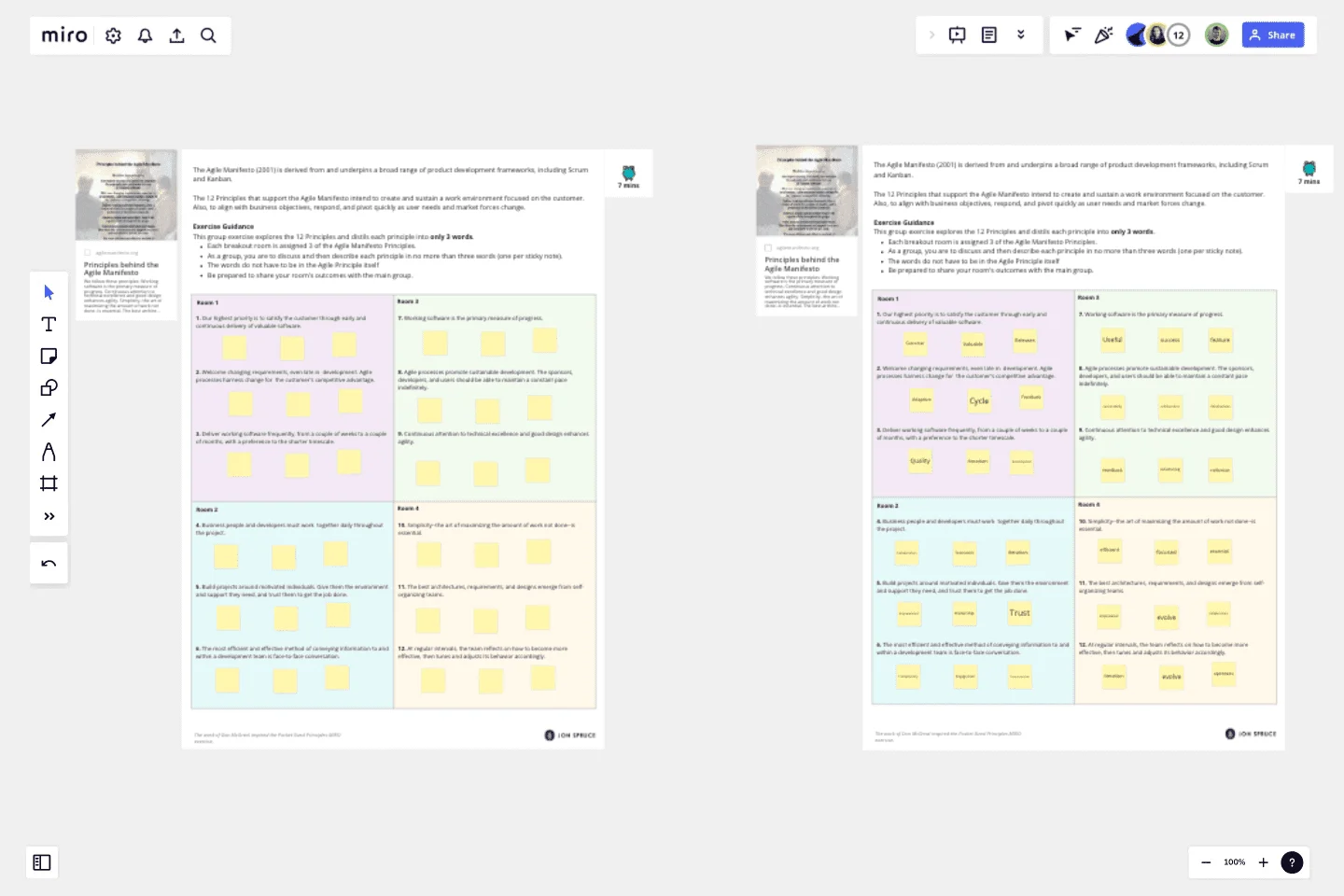The Agile Manifesto - Pocket Sized Principles
Embrace agile principles with The Agile Manifesto - Pocket Sized Principles template. Reinforce collaboration, adaptability, and customer focus.
The 12 Principles that support the Agile Manifesto intend to create and sustain a work environment focused on the customer. Also, to align with business objectives, respond, and pivot quickly as user needs and market forces change.
The 12 Principles of the Agile Manifesto
Satisfying customers through early and continuous delivery of valuable work.
Breaking big work down into smaller tasks that can be completed quickly.
Recognizing that the best work emerges from self-organized teams.
Providing motivated individuals with the environment and support they need and trusting them to get the job done.
Creating processes that promote sustainable efforts.
Maintaining a constant pace for completed work.
Welcoming changing requirements, even late in a project.
Assembling the project team and business owners on a daily basis throughout the project.
Having the team reflect at regular intervals on how to become more effective, then tuning and adjusting behavior accordingly.
Measuring progress by the amount of completed work.
Continually seeking excellence.
Harnessing change for a competitive advantage.
Exercise Guidance
This group exercise explores the 12 Principles and distils each principle into only 3 words.
Each breakout room is assigned 3 of the Agile Manifesto Principles.
As a group, you are to discuss and then describe each principle in upto (but no more than) three words.
Each word should be on a separate sticky note.
The words do not have to be in the Agile Principle itself
Be prepared to share your room's outcomes with the main group.
The most valuable part is their discussion when coming up with the words, as they will all need to understand the principle before describing it.
The Pocket Sized Principles MIRO exercise was inspired by the work of Don McGreal.
This template was created by Jon Spruce.
Get started with this template right now.
Goal Tracker Template for Small Businesses
Works best for:
Kanban Boards, Agile Methodology, Agile Workflows
Goal Tracker Template for Small Businesses empowers small businesses to set and track their goals effectively. By visualizing goals, milestones, and progress, this template fosters accountability and motivation. With features tailored to small business needs, such as revenue tracking and customer acquisition goals, teams can prioritize initiatives and make data-driven decisions to drive growth and success.
Kanban Pizza Game
Works best for:
Agile, Kanban
The Kanban Pizza Game is an interactive way for teams to learn and apply Kanban principles. By simulating a pizza delivery process, teams experience how to visualize work, limit work in progress, and optimize flow. Through rounds of iteration and reflection, participants gain insights into continuous improvement and lean thinking, fostering collaboration and driving efficiency. Get ready to slice through inefficiencies and deliver value faster with the Kanban Pizza Game!
Monthly Planner Template
Works best for:
Operations, Strategic Planning, Project Planning
To knock out every task and accomplish every goal for the month, it helps to take a big picture, 10,000 foot view of things—meaning a 30-day view. That’s why a monthly calendar can come in so handy, especially on bigger projects. Use our template to create a visual representation that helps you track and space out every deadline and to-do, both for individuals and full teams. You’ll even be able to customize it your way, with images, video, and sticky notes.
To-do List Template
Works best for:
Project Management, Education, Decision Making
A to-do list helps teams manage, organize, and prioritize their upcoming tasks. As a result, they can improve time management and streamline work operations. Using Miro’s to-do list template, teams create interactive, collaborative, and user-friendly task lists.
Work Breakdown Structure Template
Works best for:
Project Management, Mapping, Workflows
A work breakdown is a project management tool that lays out everything you must accomplish to complete a project. It organizes these tasks into multiple levels and displays each element graphically. Creating a work breakdown is a deliverable-based approach, meaning you’ll end up with a detailed project plan of the deliverables you must create to finish the job. Create a Work Breakdown Structure when you need to deconstruct your team's work into smaller, well-defined elements to make it more manageable.
Growth Experiments Template
Works best for:
Leadership, Desk Research, Strategic Planning
Many ambitious companies are eying the future and aiming to grow. But growth decisions can be leaps of faith that are risky and costly. That’s why growth experiments make so much sense. They offer a systematic six-step method that reveals which strategies are most effective, how they’ll affect your revenue, and how they compare to your past approaches. By helping you test out your strategies for scaling your business before you fully commit, growth experiments can save you serious time, resources, and money.
